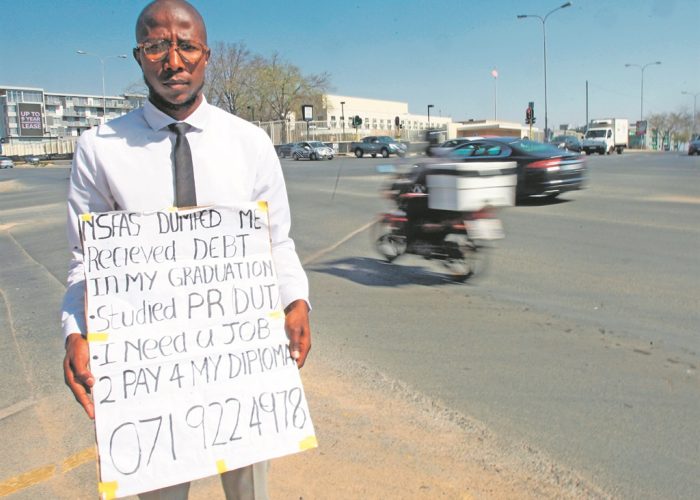



Thembinkosi Phakathi, an unemployed youth who begs at the corner of Rivonia Road and Sandton Drive in Johannesburg, is a public relations graduate who has taken to the streets to beg for a job. Picture: Gallo Images/Sowetan/Antonio Muchave
By
Despite more than two decades of government policy intervention to tackle youth unemployment, race remains one of the three main structural barriers that keep black and coloured youths out of work.
This is according to a damning report released by Stats SA on the social profile of youth in the country between 2009 and 2014, which also found that the number of female entrepreneurs between the ages of 15 and 34 declined by 6.2% in the same period.
Statistician-General Pali Lehohla said female youths were giving up the space already largely occupied by male counterparts to male entrepreneurs, who declined by only 0.9% in comparison.
While young entrepreneurs declined by 2.6% between 2009 and 2014, from 29.8% to 27.2%, young female entrepreneurs showed a 6.2% decline.
He warned that the current trends would be “detrimental” to the potential growth of the workforce in the coming years as employers found it difficult to fill posts with skilled people.
Lehohla said that without a significant investment in young people’s education, South Africa would not realise a demographic dividend, a boost in economic activity as a result of an increase in the number of young people and a declining fertility rate.
He painted a gloomy picture of South Africa’s future, particularly concerning the decline in both the number of youths in the country’s population, youths studying at universities and the decline in young entrepreneurs, as this was indicative of a country that needed new policies to tackle the problem.
Education policies geared towards increasing the right level of skills among the youth was the only way to change the bleak future faced by the country’s youngsters.
“Efforts directed towards tackling the scourge of youth unemployment have to address structural factors contributing to this troubling phenomenon. The structural factors relate mainly to education, skills insofar as work experience is concerned and race,” said the report.
“Efforts to tackle the scourge of youth unemployment, therefore, have to address structural factors relating to education and skills development.”
The unemployment rate for the youth had also significantly increased from 34.2% in 2009 to 35.9% in 2014, compared with adults, whose unemployment rate increased from 13.4% in 2009 to 15.7% in 2014.
Lehohla attributed the country’s unemployment woes to a lack of education. One glaring statistic shows that while the proportion of black and coloured youths who completed a bachelor’s degree almost doubled during the advent of democracy in the early 1990s, completion rates sharply declined after 2000.
However, white and Indian or Asian youths doubled their participation at universities in the same period.
Of particular interest in the report was that the share of unemployed young people who didn’t have a matric remained unchanged at 57% from 2009 to 2014.
While private sector internship and entrepreneurship were some of the policy measures geared towards decreasing youth unemployment and increasing skills development, the study found a decline of 2.7% in the total share of young entrepreneurs, which was driven mostly by a larger decrease in female entrepreneurs than in male entrepreneurs.
“What we’re seeing here is that movement is something that happens in life, and we see that the growth of the South African population was 6.9% from 2009 to 2014, but growth in youth population was 6%, smaller than overall growth in the entire population,” said Lehohla.
“If your youth is becoming a smaller proportion, or rather growing at a lower rate, it means that the cohorts that were born have become smaller and smaller relative to the cohorts born prior to that period.”
He said crime surveys proved what had been known for a long time, that unemployed youths generally turned to crime or became victims of crime, with those aged between 16 and 34 twice as likely to fall victim to assault or robbery compared with their adult counterparts.
Measuring the unemployment rate by race, Lehohla said white people were closest to the 5% unemployment figure, which meant there was virtually no unemployment as this group accounted for only 7.3% of the expanded unemployment rate between 2009 and 2014.
Black people of working age – between the ages of 15 and 65 – accounted for the largest proportion of the expanded unemployment rate at 28.6%, followed by coloured people at 24.1%, while the Asian or Indian population accounted for 11.5%. –city-press.news24.com
Follow us on Twitter @FingazLive and on Facebook – The Financial Gazette